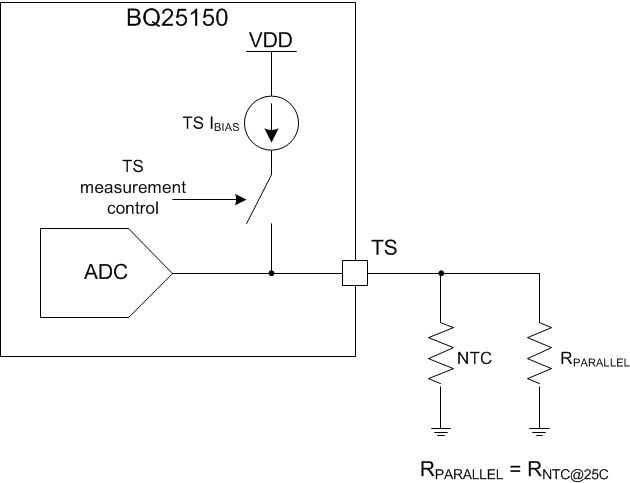SLUSD04C july 2018 – april 2023 BQ25150
PRODUCTION DATA
- 1 Features
- 2 Applications
- 3 Description
- 4 Revision History
- 5 Description (continued)
- 6 Device Key Default Settings
- 7 Pin Configuration and Functions
- 8 Specifications
-
9 Detailed Description
- 9.1 Overview
- 9.2 Functional Block Diagram
- 9.3
Feature Description
- 9.3.1 Linear Charger and Power Path
- 9.3.2 Protection Mechanisms
- 9.3.3 ADC
- 9.3.4 VDD LDO
- 9.3.5 Load Switch / LDO Output and Control
- 9.3.6 PMID Power Control
- 9.3.7 MR Wake and Reset Input
- 9.3.8 14-Second Watchdog for HW Reset
- 9.3.9 Faults Conditions and Interrupts ( INT)
- 9.3.10 Power Good ( PG) Pin
- 9.3.11 External NTC Monitoring (TS)
- 9.3.12 External NTC Monitoring (ADCIN)
- 9.3.13 I2C Interface
- 9.4 Device Functional Modes
- 9.5 Register Map
- 10Application and Implementation
- 11Power Supply Recommendations
- 12Layout
- 13Device and Documentation Support
- 14Mechanical, Packaging, and Orderable Information
Package Options
Mechanical Data (Package|Pins)
- YFP|20
Thermal pad, mechanical data (Package|Pins)
Orderable Information
9.3.11.1 TS Thresholds
The BQ25150 monitors the TS voltage and sends an interrupt to the host whenever it crosses the VHOT, VWARM, VCOOL and VCOLD thresholds which correspond to different temperature thresholds based on the NTC resistance and biasing. These thresholds may be adjusted through I2C by the host. The device will also disable charging if TS pin exceeds the VTS_OPEN threshold.
The TS biasing circuit is shown in Figure 9-8. The ADC range is set to 1.2 V. Note that the respective VTS and hence ADC reading for TCOLD (0°C), TCOOL (10°C), TWARM (45°C) and THOT (60°C) changes for every NTC, therefore the threshold values may need to be adjusted through I2C based on the supported NTC type.
 Figure 9-8 TS Bias Functional Diagram
Figure 9-8 TS Bias Functional DiagramThe BQ25150 supports by default the following thresholds for a 10-KΩ NTC.
| THRESHOLD | TEMPERATURE (°C) | VTS (V) |
|---|---|---|
| Open | -- | >0.9 |
| Cold | 0 | 0.585 |
| Cool | 10 | 0.514 |
| Warm | 45 | 0.265 |
| Hot | 60 | 0.185 |
For accurate temperature thresholds a 10-KΩ NTC with a 3380 B-constant should be used (Murata NCP03XH103F05RL for example) with a parallel 10-KΩ resistor. Each threshold can be programmed via I2C through the TS_COLD, TS_COOL, TS_WARM and TS_HOT registers. The value in the registers corresponds to the 8 MSBs in the TS ADC output code.